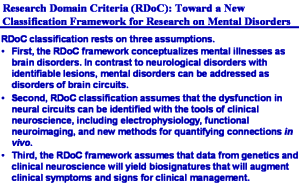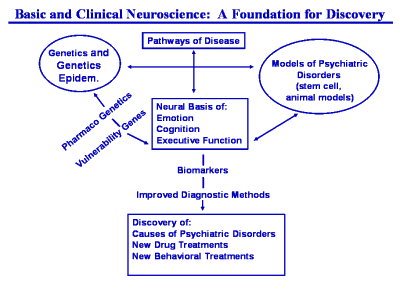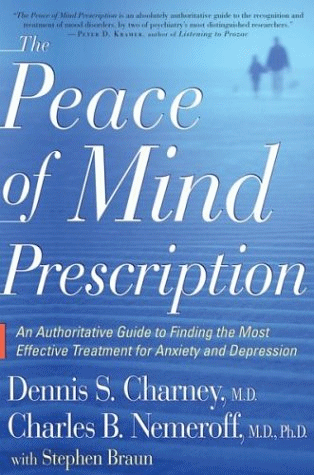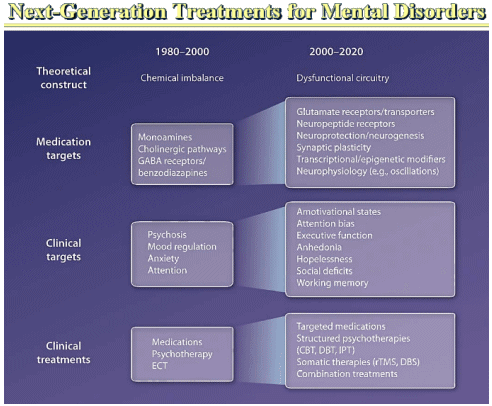| New opportunities for treatment development. The enormous expansion of the medication portfolio for mental disorders between 1980 and 2000 was limited to a relatively narrow space of biology. Over the past decade, a new focus on the genetics and neurobiology of these disorders has generated a range of new targets for next-generation treatments. In addition, the broad categories of symptoms [analogous to fever or pain] are giving way to more targeted clinical symptoms that cut across current diagnostic bins[e.g., anhedonia and social deficits]. And the limited options for treatments is expanding to include targeted behavioral interventions disseminated via new media, innovative somatic treatments based on identified circuit dysfunction, and strategic combinations [such as cognitive enhancers to improve the impact of cognitive behavior therapy]. ECT, electroconvulsive therapy; CBT, cognitive behavioral therapy; DBT, dialectical behavior therapy; IPT, interpersonal behavior therapy; rTMS, transcranial magnetic stimulation; DBS, deep brain stimulation. |
This slide and text come from a presentation by Dr. Dennis Charney, now Dean at Mount Sinai, called "A Roadmap for Innovation in Psychiatry." We’ve probably all been to such talks about the future – what’s in the ‘pipeline’ or what’s coming ‘down the pike.’ The usual format is to have the last great disappointments on the left and the next great hopes on the right. Since the 1980 revolution in psychiatry, we’ve had way more than our share of such presentations – with words like ‘innovation’, ‘novel’, advances in’, ‘neurobiology of’, etc. The oddity about this slide is that the column on the left could have been headed with ‘1960-1980’ instead of ‘1980-2000’ – or even ‘1960-present.’ And we all know it – that the efforts of the last thirty years have not born much promised fruit. So the presentations these days have something of a desperate quality, suffused with speculation.
Brain circuitry model for mental illness will transform management, NIH mental health director says
British Medical Journal
by Caroline White
1 September 2011The field of mental health is on the cusp of a revolution, which is set to transform the diagnosis and treatment of mental illness and reverse the lack of major progress made in curbing associated ill health and death over the past 100 years, the director of the US National Institute of Mental Health, has claimed…
The seismic shift had been driven by what he described as three “revolutionary changes” in thinking, the first of which was that mental illness was increasingly being recognised as a disorder of brain circuitry, rather than as a chemical imbalance, thanks to neuroimaging techniques and the discovery of some key biomarkers…
Secondly, mental ill health was now recognised as a developmental disorder for which early intervention was vital, said Professor Insel, highlighting US research showing that 50% of study participants had reported the onset of mental health problems by the age of 14, and 75% by the age of 24. “We are still stuck with getting to the problem very late. The future will be about understanding the trajectory of illness so that we can identify the first signs before it develops into psychosis,” he said…
The third change was the recognition that mental ill health is a complex mix of genetic and experiential factors. “This is not new,” he affirmed. “But what is new is the ability to probe the genetics of the disorder”…
And traditional psychiatric diagnosis is out, even with the leaders of the diagnostic manual revision team itself. Since neither pharmacotherapy nor the lab findings map to clinical psychiatric diagnoses, psychiatry is apparently going to try to map itself onto our pharmacology and a variety of technologies. Charney’s version:

Leading Charney, like the DSM-5 Task Force leaders, like Dr. Insel, to the NIMH RDoC and its assumptions:

I won’t go on and on about Dr. Charney’s presentation. The slides are available for all to see. It’s a potpourri of neuroscience concepts that seem to be strung together almost at random, ending with this slide:

 I used the words "desperate" and "speculative" earlier to describe many of the recent presentations about the future – and this one gets high marks in both categories. Some are using the term "cargo cult science" to describe talks like this – referring to the aboriginals who build primitive airstrip facimiles in hopes of attracting planes like the real airfields they’ve seen eg throwing out neuroscience concepts hoping to attract something of value. It’s a good analogy, but another occurred to me as I thought about his slide presentation.
I used the words "desperate" and "speculative" earlier to describe many of the recent presentations about the future – and this one gets high marks in both categories. Some are using the term "cargo cult science" to describe talks like this – referring to the aboriginals who build primitive airstrip facimiles in hopes of attracting planes like the real airfields they’ve seen eg throwing out neuroscience concepts hoping to attract something of value. It’s a good analogy, but another occurred to me as I thought about his slide presentation.

 In my last post, I used a recent beach scene, a dancing heron. The story behind that picture is more complicated than shows. The heron stood like a wood carving, transfixed on a man fishing in the surf.
In my last post, I used a recent beach scene, a dancing heron. The story behind that picture is more complicated than shows. The heron stood like a wood carving, transfixed on a man fishing in the surf.  Then, the fisherman hooked a fish, and the heron became excited and watched the line as intently as the fisherman himself. The heron’s dance came when a small fish was landed. The fisherman dutifully turned it over to the eager heron who took off in a flash. I had seen the Charney slides the evening before, so my analogy is obvious – the layer of KOLs watching and waiting for anything in the exciting neuroscience literature to translate into some future breakthrough.
Then, the fisherman hooked a fish, and the heron became excited and watched the line as intently as the fisherman himself. The heron’s dance came when a small fish was landed. The fisherman dutifully turned it over to the eager heron who took off in a flash. I had seen the Charney slides the evening before, so my analogy is obvious – the layer of KOLs watching and waiting for anything in the exciting neuroscience literature to translate into some future breakthrough.

 And then… a lady with a red hat walked towards the beach with the remains of her sandwich, and the formerly statuesque gulls came to life – and I had an even better analogy. I think that’s how I see a large segment of the upper echelon of psychiatric KOLs – just waiting for anything that comes along to pounce on and turn into one of these futuristic articles or presentations, particularly in this time of famine with the PHARMA pipeline slowed to a barely a trickle [if even that].
And then… a lady with a red hat walked towards the beach with the remains of her sandwich, and the formerly statuesque gulls came to life – and I had an even better analogy. I think that’s how I see a large segment of the upper echelon of psychiatric KOLs – just waiting for anything that comes along to pounce on and turn into one of these futuristic articles or presentations, particularly in this time of famine with the PHARMA pipeline slowed to a barely a trickle [if even that].
 I’m as interested in the findings of the modern bench neuroscientists as the next guy. They are on a roll, at the threshold of many things to come in the distant future. But in clinical psychiatry, this is hardly the time for wild speculations or desperate claims of breakthroughs just around the corner. This is an age where former irrational exuberance and broken promises hang thickly in the air – a time when the unimaginable corruption of the not so distant past is becoming increasingly clear with every passing day. Dr. Charney has over 500 articles in PubMed. He has a book, the Peace of Mind Prescription, coauthored by the infamous Dr. Charles Nemeroff actually written by Stephen Braun [suspicious mind[s]…]; Charney was an author on the ghost-written paper that got Dr. Nemeroff removed as editor for Neuropsychopharmacology [sally’s world…]; and he and Dr. Dwight Evans signed on to a ghost-written infomercial editorial in Biological Psychiatry in 2003 exposed by POGO [roaches…]. Each of these outings were PHARMA funded. Dr. Charney is a solid member of what has been called the academic-pharmaceutical complex.
I’m as interested in the findings of the modern bench neuroscientists as the next guy. They are on a roll, at the threshold of many things to come in the distant future. But in clinical psychiatry, this is hardly the time for wild speculations or desperate claims of breakthroughs just around the corner. This is an age where former irrational exuberance and broken promises hang thickly in the air – a time when the unimaginable corruption of the not so distant past is becoming increasingly clear with every passing day. Dr. Charney has over 500 articles in PubMed. He has a book, the Peace of Mind Prescription, coauthored by the infamous Dr. Charles Nemeroff actually written by Stephen Braun [suspicious mind[s]…]; Charney was an author on the ghost-written paper that got Dr. Nemeroff removed as editor for Neuropsychopharmacology [sally’s world…]; and he and Dr. Dwight Evans signed on to a ghost-written infomercial editorial in Biological Psychiatry in 2003 exposed by POGO [roaches…]. Each of these outings were PHARMA funded. Dr. Charney is a solid member of what has been called the academic-pharmaceutical complex.

I run a blog called ‘The Fibromyalgia Perplex’ (named after Frederick Crew’s 60’s The Pooh Perplex). Many of the issues we deal with are similar to yours, but psychiatry is a bigger, more lucrative target. I took the opportunity to put a small post up on our site suggesting our readers my stop by ‘1 Boring Old Man.’ I wrote:
We sub-specialists tend to stay around our own field, but many of the same issues come up in other allied specialties. I have been following a blog entitled ‘1 Boring Old Man,’ a psychiatry blog. Psychiatry seems to have many of the same problems and directional issues that we have. But they have more excitement: real villains, doctored and suppressed studies, law suits, DSM controversies, and so on. We do have a few villains and a couple of doctored studies, but not to the extent that is seen in psychiatry. I was in the midst of writing a post about ‘Fibromyalgia: On the Take – Pharma, Physicians and Professional Organizations’ when I came across the 1 Boring Old Man post. It’s worth looking at, and it does put our issues into perspective, too. See http://1boringoldman.com/index.php/2013/03/05/some-time-back/
This is an important post that I hope gets widely viewed.
We are an innovative culture, aren’t we? And when innovation is slow, we get a tad bit frantic.
I read through the whole presentation jamzo linked myself.
The first thing I noticed was all ‘Clinical Targets’ were still subjective observations. So it didn’t surprise me all the treatments of the ‘future’ were also intended to produce only a subjective effect too.
It really is outrageously bizarre the APA chose to take a half-step in the direction of calling ‘Mental illness” a brain malfunction, and while maintaining only subjective criteria to identify this supposed malfunction by. That’s certainly the reason the Biological DSM-5 failed. No amount of reasoning or tinkering can ever turn a subjective observation into an objective one.
What’s even more bizarre are people like Dr. Charney. Modern American Psychiatry is perhaps the biggest ghost specialty that ever existed.
If ever there was a good term describe all this, it would be ‘cargo cult science’.
Right on, Mickey.
Life is a box of buzzwords.
Be prepared to see a lot stories like this one, in search of brain circuits:
World’s most detailed scans will reveal how brain works http://www.bbc.co.uk/news/science-environment-21660159
So researchers will be/are peeking into the brains of live people, presented to the public in beautifully coloured pictures. Then, the how of it all, unimaginable amounts of data, hugh computers needed, then why..
That the brain works is not the same as answering how, is it? Or how the mind works, offered to students in an open course in psychology at Yale, http://www.oyc.edu